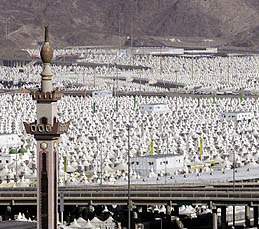In the forenoon of the eighth day of Thul-Hijjah (Tarwiyah Day), the pilgrim who is performing Tamattu‘ Hajj should reassume his state of Ihraam (sacral state) from the place where he is stationed, by bathing, applying perfume and then wearing Ihraam clothes as he has previously done when performing ‘Umrah (lesser pilgrimage). Then, he should say: “Labbayka Hajjan, Labbayka Allahumma Labbayk. Labbayka laa Shareeka laka Labbayk…. (Here I am at Your service with the intention of performing Hajj. Here I am at Your service, Oh Allah; here I am at Your service. Here I am at Your service, there are none worthy of worship except You Alone).”
As for the pilgrim who performs Qiraan or Ifraad, they should maintain their first state of Ihraam.
A pilgrim should then proceed to Mina, where he should perform the Thuhr (afternoon), ‘Asr (post-noon), Maghrib (sunset), ‘Ishaa’ (night) and Fajr (dawn) prayers, shortening his four-Rak‘ah (unit) prayers to two Rak’ahs each, but without combining them, as the Prophet ![]() did so. Spending this night at Mina is an act of Sunnah (tradition), not an obligatory act of Hajj.
did so. Spending this night at Mina is an act of Sunnah (tradition), not an obligatory act of Hajj.
When the sun of the 9th day of Thul-Hijjah rises (the Day of ‘Arafah), the pilgrim should proceed from Mina to ‘Arafah and stay at Namirah until noon when the sun descends from the middle of the sky if this was possible. After this happens, he should perform advance combination of the Thuhr and ‘Asr prayers at the time of Thuhr prayer, performing each prayer with two Rak‘ahs, with one Athaan (call for prayer) and two Iqaamahs (second call for prayer), as the Prophet ![]() did.
did.
Then, he should remain within the borders of ‘Arafah until sunset occupying himself with the remembrance of Allah The Almighty, making as many supplications as possible and reciting the Quran. The pilgrim should be keen on making use of his time by asking Allah The Almighty to grant him from His bounty in this worldly life and the Hereafter, with his hands raised and his face towards the Qiblah (direction of Ka'bah). He should spend his time in deep supplication because the best of supplication is the supplication of the Day of ‘Arafah, as the Prophet ![]() informed us.
informed us.
Upon sunset a pilgrim should head from ‘Arafah to Muzdalifah in tranquility and solemnity while frequently making Talbiyah (Saying: "Labbayka Allahumma Labbayk, Labbayka laa Shareeka laka Labbayk, Innal-Hamda wan-ni‘mata laka walmulk, laa Shareeka lak."), and there in Muzdalifah he prays Maghrib (three Rak‘ahs) and ‘Ishaa’ (two Rak‘ahs), with one Athaan and two Iqaamahs. Then the pilgrim sleeps until Fajr prayer. After performing Fajr prayer, he should go to Al-Mash’ar Al-Haraam (a place in Muzdalifah where the Masjid exists) if he is able to, in order to supplicate and remember Allah The Almighty until just before sunrise. However, if he was not able to go to Al-Mash`ar Al-Haraam, it is permissible for him to make supplications in his place.
Then, the pilgrim should head to Mina before sunrise while making Talbiyah. However, if the pilgrim has a valid excuse approved by the Sharee’ah (Islamic legislation), such as the weak persons and women, then it is permissible for the pilgrim to head to Mina after midnight taking seven pebbles with him to throw the Jamrah of Al-‘Aqabah (largest pillar). He can either pick these pebbles from Muzdalifah, on the way, or from any other place. Upon reaching the Jamrah of Al-‘Aqabah, which is the closest to Makkah, he should stop his Talbiyah and throw the Jamrah of Al-‘Aqabah with seven consecutive pebbles while saying with each one, “Allahu Akbar (Allah Is The Greatest).”
After that, the pilgrim should slaughter the sacrificial animal, if it is obligatory upon him. The male pilgrim should shave or shorten his hair, but shaving is more preferable. A woman should only shorten her braids the length of a knuckle.
With that, one makes the first dissolution of Ihraam. He may do all that he was prohibited from due to being in the state of Ihraam, except engaging in sexual intercourse with his wife.
After this, he should go to Makkah to perform Tawaaf Al-Ifaadhah (circumambulation), which is a pillar of Hajj. This Tawaaf is exactly the same as the one described in the rites of ‘Umrah, without Ar-Ramal (brisk walking) or Idhtibaa‘ (uncovering the right shoulder). Then, he should perform two Rak‘ahs behind Maqaam Ibraaheem (Station of Ibraaheem) as we mentioned in ‘Umrah.
After performing Tawaaf, the pilgrim who is performing Tamattu’ Hajj should make Sa‘y (going seven circuits between Safa and Marwah), because his first Sa‘y was for the ‘Umrah and this is the Sa‘y of Hajj. As for the pilgrim who is performing Qiraan and Ifraad Hajj, they are only required to make one Sa‘y. Hence, if he had performed Sa’y following the Arrival Tawaaf, then he is not required to perform it again; otherwise, the pilgrim must perform if after Tawaaf Al-Ifaadhah.
With the completion of this Tawaaf and Sa’y, a pilgrim makes the second dissolution of Ihraam and is allowed to do everything that was lawful before commencing the state of Ihraam, including sexual intercourse with his wife.
It is better for the pilgrim to perform the rites of the Day of An-Nahr according to the mentioned order, namely, he should first throw the Jamrah of Al-‘Aqabah, then slaughter the sacrificial animal if it was obligatory upon him, then he should shave or shorten his hair, then perform Tawaaf Al-Ifaadhah, and then perform the Sa‘y if he has not performed it earlier. Nevertheless, it is permissible not abide by this order as when the Prophet ![]() was asked about advancing or delaying any of these rites on that day his answer was always: “Do it now and there is no sin.”
was asked about advancing or delaying any of these rites on that day his answer was always: “Do it now and there is no sin.”
If the pilgrim could not perform Tawaaf Al-Ifaadhah on the day of ‘Eed, it is permissible for him to delay it to the Days of Tashreeq.
After performing Tawaaf, the pilgrim should return to Mina to spend the night and throw the pebbles. If one is in a hurry, he may spend the eleventh and the twelfth nights of Thul-Hijjah only. If he wishes to prolong his stay, he should spend also the night of the thirteenth day of Thul-Hijjah in Mina, and this is better because the Prophet ![]() did so and it also implies additional good deeds. Spending the night in Mina is an obligatory act in Hajj, and it is impermissible for the pilgrim to neglect it without a valid excuse under the Sharee’ah, as what happened when the Prophet
did so and it also implies additional good deeds. Spending the night in Mina is an obligatory act in Hajj, and it is impermissible for the pilgrim to neglect it without a valid excuse under the Sharee’ah, as what happened when the Prophet ![]() permitted his uncle Al-‘Abbaas
permitted his uncle Al-‘Abbaas ![]() to spend the night in Makkah to bring water to the pilgrims.
to spend the night in Makkah to bring water to the pilgrims.
The pilgrim stones the three Jamaraat during the three days of Tashreeq. He starts with the Sughra Jamrah (smallest pillar), which is furthest from Makkah, then the Wusta Jamrah (middle pillar), and lastly the Jamrah of Al-‘Aqabah. Each one should be stoned consecutively with seven pebbles, while raising the hand and saying “Allahu Akbar (Allah Is The Greatest)” while throwing each pebble. It is an act of Sunnah to stand facing the Qiblah after throwing the Sughra and Wusta Jamrah to make supplication for a long time. As for the Jamrah of Al-‘Aqabah, one should not stand after throwing it for supplication.
The pilgrim should throw the pebbles and refrain from deputizing others except for a valid reason under the Sharee’ah, such as weakness, sickness, pregnancy, etc. As for the strong men and women, it is impermissible for them to deputize others to throw the pebbles on their behalf.
Throwing the Jamaraat during the Days of Tashreeq should be at the Thuhr prayer time (after the sun has declined from the middle of the sky), because the Prophet ![]() only threw the pebbles at that time.
only threw the pebbles at that time.
If the pilgrim throws the Jamaraat in the eleventh and twelfth day of Thul-Hijjah, then he has the option either to remain in Mina until the thirteenth day of Thul-Hijjah or leave, as Allah The Almighty Said (what means): {…Then whoever hastens [his departure] in two days -- there is no sin upon him; and whoever delays [until the third] -- there is no sin upon him - for him who fears Allah….} [Quran 2:203]
However, the pilgrim should leave before the sunset of the twelfth day of Thul-Hijjah if he wants to leave early, because staying willingly until sunset necessitates staying until spending the night of thirteenth day of Thul-Hijjah and then throwing the Jamaraat on that day at the time of Thuhr prayer.
If one was delayed after getting prepared to leave and setting out to Makkah, against his will due to a traffic jam or the like, then he is not required to stay in Mina until the next day.
When the pilgrim finishes the rites of the Days of Tashreeq and is ready to leave Makkah and return to his country, he must perform the Farewell Tawaaf, as the Prophet ![]() said: “None among you should depart until his last visit being to the House (Ka’bah).” [Muslim]
said: “None among you should depart until his last visit being to the House (Ka’bah).” [Muslim]
Menstruating women or women suffering from postnatal bleeding are permitted to depart without performing the Farewell Tawaaf.
With this, the rites of Hajj end, we ask Allah The Almighty to accept our deeds and to grant us all success.


 Home
Home Discover Islam
Discover Islam Quran Recitations
Quran Recitations Lectures
Lectures
 Fatwa
Fatwa Articles
Articles Fiqh
Fiqh E-Books
E-Books Boys & Girls
Boys & Girls  Hajj Rulings
Hajj Rulings Hajj Fatwas
Hajj Fatwas














